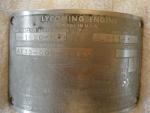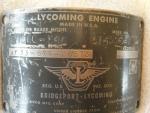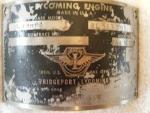
Wright Cyclone Licensees
by Carl Kuhns
21 December 2016
Introduction
During World War II, the Korean War, and the Cold War, the Wright Aeronautical Corporation could not supply the U.S. military with enough of its Cyclone engines. In contrast to Pratt & Whitney, Wright was reluctant to license its engines and only did so under pressure from the government.
Two automobile manufacturers produced Wright Cyclones for the U. S. government. During World War II, the Studebaker Corporation produced Cyclone 9s (R-1820) and Dodge-Chicago turned out Cyclone 18s (R-3350).
After World War II, the Cyclone 7 (R-1300) was made by Avco-Lycoming and Kaiser-Frazer. Also in that postwar period Cyclone 9s came out of factories owned by Avco-Lycoming and Pratt & Whitney Canada. In the early 1950s the Chevrolet Motor Division made several models of Cyclone 18s.
One Wright Cyclone engine that was only built by Wright and not by a licensee was the Cyclone 14 (R-2600). Between February 1937 and January 1946, 85,374 Cyclone 14s were made in Wright facilities in Patterson, New Jersey and Cincinnati, Ohio.
Cyclone 7 (R-1300)
The Cyclone 7 is Wright’s smallest Cyclone having only seven cylinders and a1,300 in³ displacement. Cyclone 7s were used almost exclusively as propulsion for military aircraft. Three distinct types of aircraft were powered by Cyclone 7 engines: fixed wing airplanes, helicopters and lighter than air.
The Kaiser-Frazer Corporation was a partnership between industrialist Henry J. Kaiser and automobile executive Joseph W. Frazer. Kaiser-Frazer dabbled in the manufacture of a wide range of products. Among those products were Fairchild C-119 cargo planes, automobiles and the Wright Cyclone 7 aircraft engine. Between 1952 and 1954, Kaiser-Frazer produced 1,913 Cyclone 7 engines in its Detroit, Michigan factory.
A second Cyclone 7 licensee was the Lycoming Division, Avco Manufacturing Corporation of Stratford, Connecticut. Starting in 1955 and ending in 1958, 537 Cyclone 7 engines were produced in a factory formerly owned by Chance Vought Aircraft.
 |
|
| Lycoming | Kaiser-Frazer |
Cyclone 9 (R-1820)
The Studebaker Corporation built G200 Series R-1820s between March 1942 and June 1945. Studebaker was issued a contract in December 1940 to build 6,500 R-2600 engines for the North American B -25. A main assembly plant was built in South Bend, Indiana with supporting plants in Fort Wayne, Indiana and Chicago, Illinois. Before any R-2600s could be built the Army Air Forces decided that Cyclones 9s were more urgently needed for Boeing B-17s. Total production at Studebaker was 63,789 Cyclone 9 engines. Some Studebaker Cyclone 9s are still powering touring B-17s.
A second licensee to produce Wright Cyclone 9s was Lycoming. A considerable number of HD and HE series Cyclone 9s were produced at Lycoming's Stratford Connecticut plant. Between 1952 and 1958, 3,092 HD series and 3,923 HE series were manufactured. The majority of Lycoming’s Cyclone 9 production was devoted to military aircraft, such as Grumman Tracker and Albatross twin engine aircraft. Other military aircraft using Lycoming Cyclone 9s were North American T-28s and Piasecki and Sikorsky helicopters.
A minor licensee producer of Cyclone 9s was Canadian Pratt & Whitney of Longueuil, Montreal Canada. These engines powered Grumman S2F Trackers that were built by de Havilland Canada under license from Grumman. Between November 1957 and September 1960, 287 HE-series Cyclone 9s were produced by Canadian Pratt & Whitney. As a side note these engines were given a civilian designation of 983C9HEI rather than the military one of R-1820-82 WA.
 |
 |
 |
 |
|
| Studebaker | Canadian Pratt & Whitney | Lycoming | Lycoming | Lycoming |
Cyclone 18 (R-3350)
During World War II a project almost as extensive as the Manhattan Project was the development of the Boeing B-29. Almost 4,000 B-29s were produced and that required a large number of Cyclone 18s. Wright could not produce enough engines to power the large number of B-29s that were planned. In view of Wright’s production shortcomings, the Aircraft Production Branch of the War Production board awarded the Chrysler Corporation a contract in February 1942 to build B-29 engines. An independent Dodge-Chicago Plant Division was created to manufacture these engines. A completely new plant on 375 acres was built near Chicago for the manufacture of B-29 engines Between January 1944 and September 1945 Dodge-Chicago turned out 18,413 BA series R-3350 engines.
In spite of delays in machinery deliveries and 48,500 engineering changes, Dodge-Chicago’s production record was very impressive, exceeding that of Wright Aeronautical by 4,622 engines. At the end of the war Dodge-Chicago vacated the plant and it was declared surplus. Later in the early 1950s Ford built under license from Pratt & Whitney the Wasp Major R-4360 in the vacated Dodge-Chicago Plant.
The Chevrolet Aviation Plant in Tonawanda, NY produced Pratt & Whitney R-1830 and R-2800 engines for the WWII effort. Between 1952 and 1954 this same plant produced two models of Cyclone 18s under license from Wright. The R-3350-85 engines were used in some models of the Fairchild C-119 cargo plane. Douglas Sky Raider attack aircraft were powered by Wright R-3350-26 WAs or WBs. Chevrolet produced 895 R-3350-85 engines and 1,696 R-3350-26 WA-WB engines at its Tonawanda engine plant.
| Chevrolet Wright Cyclone 18 Dataplate |
Soviet-Bloc Cyclone Derivatives
At some point in time, Wright Cyclone engines were sold to, given to, or taken by, the Soviet Union. A series of Cyclone-like engines was made from these acquired Wright Cyclones.
| Wright | Soviet Derivitive |
|---|---|
| Cyclone 7 (R-1300) | Ash-21, stroke reduced from 6.3125 to 6.10 inches, 1,257 in³ displacement |
| Cyclone 9 (R-1820) | M-72, M-63, M-64, 1,823 in³ displacement |
| Cyclone 14 (R-2600) | M-82, ASH-82, stroke reduced from 6.3125 to 6.10 inches 2,514 in³ displacement |
| Cyclone 18 (R-3350) | ASH-90, 3,347 in³ displacement |
References
Hyde, Charles K. Arsenal of Democracy Wayne State University Press. 2013
Stout, Wesley W. Great Engines and Great Planes, Chrysler Corporation
Wilkinson, Paul H. Aircraft Engines of the World 1947 and 1957 Editions
White, Graham, Allied Aircraft Piston Engines Society of Automotive Engineers, Inc. 1995
Wright Aeronautical Divisions (and Licensee) Shipments, 1920-1960#CW
Curtiss-Wright Engine Specs, 1930 - 1983 (4.3M PDF)